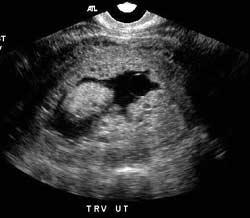What Is A Molar Pregnancy and How Is It Treated?
 A molar pregnancy is the result of an in placenta which is caused by a problem when the egg and sperm join at fertilization. Molar pregnancies are usually extremely rare – occurring only in 1 out of every 1000 pregnancies
A molar pregnancy may also be called gestational trophoblastic disease (GTD), hydatidiform mole
There are two types of molar pregnancy:
A molar pregnancy is the result of an in placenta which is caused by a problem when the egg and sperm join at fertilization. Molar pregnancies are usually extremely rare – occurring only in 1 out of every 1000 pregnancies
A molar pregnancy may also be called gestational trophoblastic disease (GTD), hydatidiform mole
There are two types of molar pregnancy:
- Complete molar pregnancy. In place of a normal placenta and embryo, the hydatidiform mole is abnormal placental tissue that grows into a grapelike cluster that can fill the uterus
- Partial molar pregnancy. Partial Mole occurs when the mass contains both the abnormal cells and an embryo that has severe defects. In this case the fetus will be overcome by the growing abnormal mass rather quickly
- An extremely rare version of a partial mole is when twins are conceived but one embryo begins to develop normally while the other is a mole. In these cases, the healthy embryo will very quickly be consumed by the abnormal growth
What Are The Risks Associated With Molar Pregnancy?
A hydatidiform mole can cause excessive bleeding from the uterus. A small percentage of molar pregnancies lead to abnormal cell growth called gestational trophoblastic disease. This is a growth of abnormal tissue inside the uterus during pregnancy that prevents the normal growth of a fetus. In some cases this tissue may continue to grow after a miscarriage and in some cases lead to uterine cancer or even spread to other parts of the body- 15% to 20% Of complete molar pregnancies develop trophoblastic disease and only a small percentage of these may become invasive cancer. Of those which do develop invasive cancer – almost 100% of them are cured
- Only around 5% of partial molar pregnancies develop trophoblastic disease.
Who Is At Risk Of A Molar Pregnancy?
In the US, approximately 1 out of 1,000 pregnancies is a molar pregnancy Mexico, Southeast Asia, and the Philippines have higher rates than the US for molar pregnancies in women White women in the US are at higher risk than black women Women over the age of 40 Women who have had a prior molar pregnancy Women with a history of miscarriageWhat Causes A Molar Pregnancy?
It is thought that a molar pregnancy may be caused by a problem with the genetic information of an egg or sperm. An abnormal egg with no genetic information is fertilized by a sperm. The sperm’s chromosomes duplicate and develop into a complete mole A normal egg is fertilized by two sperm. This cell mass is most likely to develop into a partial moleWhat Are The Symptoms Of A Molar Pregnancy?
- Vaginal spotting or bleeding
- Nausea and vomiting
- Develop rare complications like thyroid disease
- Early preeclampsia (high blood pressure)
- Increased hCG levels
- No fetal movement or heart tone detected
How Is A Molar Pregnancy Treated?
If you are diagnosed with a molar pregnancy, you will need immediate treatment to remove all molar growth from your uterus. After your uterus is cleared of molar tissue, you will have periodic hCG blood tests to screen for signs of persistent cell growth (trophoblastic disease) in your uterus. These tests are done periodically for 6 to 12 months. In some cases, trophoblastic disease can develop into trophoblastic cancer. However, most cases are identified early, located in the uterus only, and are highly curable with chemotherapy. In the rare case when cancer has had time to spread to another part of the body, more aggressive chemotherapy is necessary, sometimes combined with radiation treatment. Most women who have been treated for trophoblastic disease are still able to become pregnant After having a molar pregnancy, it is common to feel grief over losing a pregnancy and be fearful about cancer risk. Consider contacting a support group or talking to friends, a counselor, or religious advisor to help you and your family deal with this difficult time.Molar Pregnancy


